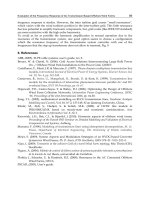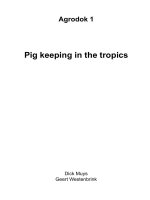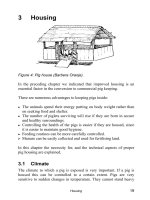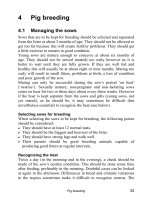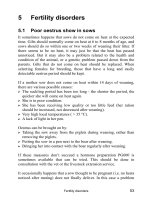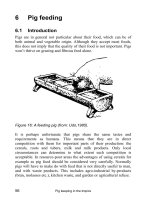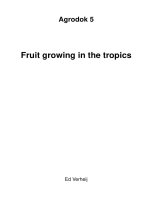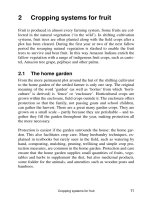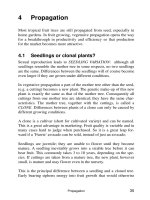Erosion control in the tropics - Part 5 pptx
Bạn đang xem bản rút gọn của tài liệu. Xem và tải ngay bản đầy đủ của tài liệu tại đây (276.37 KB, 18 trang )
Erosion control in the tropics 30
5 Agronomic methods to control
erosion
Agronomic methods include those erosion control measures that are
related to arable farming. It is concerned with crop cultivation itself as
well as tillage operations. Arable farming is an integral part of the
natural surroundings. Woodland and grassland influence arable farm-
ing. Think of the cattle pastures where manure will again benefit the
soil.
The felling of trees and the planting of trees also strongly influence
the cropping system. All this is called a farming system. We will treat
this in more detail in Chapter 6.
Agronomic measures play a key role in erosion control because in the
first place they can be carried out relatively easily and cheaply. More-
over, often results are obtained quickly and if it is still found necessary
to take technical measures, they contribute considerably to their suc-
cess (see Chapter 7).
In this chapter we will give a survey of the most important agronomic
measures. The principles of these measures are given in Chapter 3 and
should be clear.
? Contour farming and strip cropping aim at preventing water to run
off and at retaining the rain water.
? Minimum tillage, mulching and the use of a cover crops serve to
protect the soil against the force of the rainfall, at the same time
maintaining the soil fertility or increasing it.
? Manuring has the role of keeping the crop in good condition so that
it can stand up to erosion better.
? Finally, mixed cropping aims at good crop growth with optimal use
of available light, water and nutrients. This minimizes the chance of
erosion.
Agronomic methods to control erosion 31
Of each measure principles and execution are treated as well as draw-
backs. Too detailed advice of course cannot be given for the execu-
tion; you will have to find out for yourself whether and how certain
procedures can be carried out best in your local situation. Mixed crop-
ping, for example will require a suitable combination of crops. Con-
sultation with the local population and institutions is important here to
benefit from the knowledge and experience of others. There will be a
greater chance that the operations succeed too.
You can find more information about agronomic measures to control
erosion and to improve infiltration of water and retention of water by
the soil in two other publications in the Agrodok series: No. 2: ‘Soil
fertility management’; and No 13: ‘Water harvesting and soil moisture
retention’.
5.1 Contour farming
Contour farming is a collective name for contour ploughing and con-
tour planting. This means that soil cultivation and planting are carried
out along the contours.
Purpose:
? To prevent water from running off down-slope (see figure 13).
? To encourage infiltration of water into the soil.
Figure 13: Contour farming
Erosion control in the tropics 32
Application:
In general contour farming is practised if the slope is not steeper than
about 10% but longer than 100m. On steeper slopes, combined meth-
ods are used. This is the easiest procedure (however remember the
10%). This method is sometimes combined with terracing and strip
cropping which makes it more effective.
To show how the contours run, hedges can also be planted along the
contours. If the farmer keeps ploughing parallel to the hedge, he will
have the assurance that everything is following the contour line. This
is difficult to see without a guideline. The hedge should not in any
way be an obstacle; it is even possible to make good use of them as
well (fodder crop, firewood, fruits, mulch) (see figure 14).
Figure 14: Hedges along the contour
For the purpose of erosion control only ridges and furrows should be
as horizontal as possible. However, in practice this doesn’t work out.
There is a chance that the water collects at a somewhat lower point in
a furrow behind a ridge and causes the ridge to break through, and
with it the lower lying ridges; the results of all this being disastrous.
So it is better to make a point of laying out ridges and furrows at a
slight angle; about 1%, so that run-off water can be collected and
safely removed via a discharge drain. The furrow should not be longer
than 100m to avoid over flowing and also to reduce the stream veloc-
ity. Drainage channels can of course be used provided they are kept
under plant cover.
Small dams (cross-ties) made of earth can be made at regular intervals
in the furrows to check the water velocity; this is known as the ‘tied
Agronomic methods to control erosion 33
ridging system’ (see figure 15). If the rainfall is not so heavy it will be
completely taken up in the soil. The method is effective in dry areas.
Figure 15: Tied-ridging
Execution:
First a number of contour lines have to be established for ploughing to
be carried out. It is useful to set fixed orientation points for this so that
the contours do not have to be set out again every year (see also ap-
pendix 1).
Possible drawbacks:
? If ridges and furrows are badly laid out, this may lead to more ero-
sion. Water may collect at certain points and if the ridges break,
there is a danger of gully erosion.
? Contour farming can also be risky if:
1 The soil has a low infiltration velocity (see glossary). This is the
case on very heavy soils or if there is a hard layer in the profile.
2 The soil has a low infiltration capacity (Glossary). This is the
case if the soil layer is shallow or has impermeable layers.
? Under these circumstances, a lot of water will collect, increasing the
chance of breaking.
? On very irregular slopes it may be impractical to work along the
contours. Strip cropping may be more effective here.
? Finally, for contour ploughing, a plough with a reversible blade is
preferable.
Erosion control in the tropics 34
5.2 Strip cropping and strip reclamation
Strip cropping is the cultivation of different types/sorts of crops
planted in separate strips along the contour. Strips that do not stand up
to erosion well are alternated with strips that can withstand erosion.
In strip reclamation the original vegetation is left to grow in places
where there is a danger of erosion. Strips that are a poor protection
against erosion are alternated with strips that are well protected by a
crop (see figure 16).
Figure 16: Strip cropping
Purpose:
? To hold back the run-off water with soil particles coming from the
poorly protected strip, in the strip with the dense cover crop. Here
water penetrates well and soil particles are held. In this way, the un-
derlying strips are protected.
? In addition, the ‘soil protective’ strips can be used to provide cattle
feed and/or mulch.
Application:
Strip planting is usually carried out on slopes that are not steep enough
to warrant terracing, which are slopes of 15 to 20%. From a financial
point of view and the technical know-how involved, strip planting is
often preferred to terracing; the results of all this being disastrous.
Agronomic methods to control erosion 35
So it is better to make a point of laying out ridges and furrows at a
slight angle; about 1%, so that run-off water can be collected and
safely removed via a lower lying ridges.
Execution:
? The strips with a poor cover crop are alternated with different strips
that do protect the soil well.
? The best combination is to alternate strips of grass or grass mixtures
with (about 25%) legumes. The strips are very suitable for provid-
ing fodder. Arable crops with a dense leaf cover can also be grown
and permit very little erosion.
? In strip reclamation, only the ‘cultivation strips’ are reclaimed, and
the natural vegetation strip holds back erosion.
? Tree crops, if pruned back to a hedge and which have an under-
cropping also provide a good buffer strip. The pruned material can
be used as a mulch and sometimes as a cattle feed.
The width of the strip depends on the gradient of the slope and the
infiltration capacity of the soil (Table 1). The principle is that the run-
off water in the strips does not reach erosive velocity. The width of the
grass/legume strips depends on the ‘correction’ that has to be made.
The water in these strips has to be halted so that the underlying strips
only have to cope with their ‘own’ water.
Table 1: A guideline for the width of strips
Slope of Width of
0 - 2% 40 - 50 m
2 - 4% 30 - 40 m
> 4% 15 - 30 m
in very humid areas 15 - 30 m
This shows that the width of the strip also depends on the rainfall. It is
useful for the farmers to decide together on the width or length of
strips. When laying out strips, one tries to let the borders run along the
Erosion control in the tropics 36
contour line. Slopes are not always regular though, so a contour line
may not be a suitable guideline for the strips to be laid out. The strips,
in order to correct the slope, will not be the same width everywhere.
This had disadvantages for arable farming in particular. Therefore ar-
able farming strips are kept the same width and the irregularities in the
slope are corrected in the buffer strips. This is less of a problem for
non-mechanized cultivation unless contour farming is carried out on
the arable strips. Strip cropping is most effective if combined with
crop rotations. The value of rotations is discussed briefly in Chapter 6.
As an illustration, we will give an example of how strip cropping is
carried out in Nigeria (Figure 17), with four crops each year.
Figure 17: Crop rotation in strip cropping
The ‘soil-protecting’ ground-nut is followed by corn which can still
benefit from the nitrogen fixed by the ground-nut. The poor soil-
covering cotton follows the corn. Three years of cultivation are fol-
lowed by three years fallow.
Agronomic methods to control erosion 37
Possible drawbacks:
? An important disadvantage of strip cropping is that it takes up a
considerable area of arable land, about one half. This is likely to be
a problem if the farm area is small. However, this does not neces-
sarily mean that yields will be halved. For instance, the strips could
be used to produce mulch material, which will increase the yield in
the crop strips. If the buffer strips are left fallow, this can be very
beneficial too. The grass/legume strips can be put to good use if cat-
tle are kept in the area, as extra feed in the dry season for example.
If the strips are very narrow, then the fencing of the strips may be a
problem. You might then consider harvesting the cattle feed your-
self keeping the cattle in the stable.
? When weeding the buffer strips care should be taken that the grass
if not trampled too much, otherwise these strips would have an ad-
verse effect.
5.3 Limitation of tillage
Techniques known as reduced, minimum and zero tillage are consid-
ered here. In zero tillage, the land for crop cultivation is not ploughed
at all, just holes for planting are made; in minimum and reduced till-
age, only the places where the crop is going to be planted or sown are
prepared, short before planting takes place. Existing vegetation and
plant residues are largely spared.
Purpose of limiting tillage:
? To prevent loosening soil material that then might form a crust or be
carried away by water.
? Left crop residues or vegetation prevent water from flowing easily
over a smooth, erosion sensitive surface. On top of that organic
matter is increased.
? There is a considerable saving of labour. Especially at high labour
peaks, the time saved means an extension of the growing season.
Planting can be done earlier though.
Erosion control in the tropics 38
Application:
Reduced tillage is especially advisable on soils that easily form a crust
on the newly worked soil. The soils should be well draining (i.e. not
too clayey) have a crumbly consistency and a coarse surface.
Other soils may be difficult to work or there may be root systems dif-
ficult to break through. This technique is often combined with strip
cropping and terracing.
Execution:
From the moment the soil is most sensitive to erosion (from tillage
until a cover crop forms) it should be protected against splash erosion,
by covering with plant residues. Only the vegetation around the plant
hole is cleared (Figure 18).
Figure 18: Cropping between the stubble of the previous crop
In ‘strip tillage’ only a narrow strip is worked for sowing the row crop.
Useful soil covers are often used too. As long as they do not over
grow the main crop, they are left to stand.
Minimum tillage is also often applied to relay cropping, whereby the
new crop is already sown before the previous one is harvested. A good
crop rotation can be applied in this way.
Agronomic methods to control erosion 39
Possible disadvantages:
? The existing vegetation uses water which is then no longer available
for the ‘useful’ crops. To prevent this, herbicides are sometimes
used.
? Insects may thrive in the plant residues which sometimes necessi-
tates the use of insecticides.
? Initially, an increased fertilizer application, particularly nitrogen,
may be beneficial because the nitrogen from the decomposing or-
ganic material on the soil is not immediately available to the crop.
5.4 Mulching and stubble mulching
Mulching is the practice of spreading plant material or other organic
material on the surface of the soil.
In stubble mulching the crop residues from the field itself are used and
the root residues are left in the soil. In this case, tillage is restricted to
loosening the top soil (not turned over) to facilitate infiltration.
Purpose:
? To protect the soil as long as there is no cover crop. Splash erosion
and runoff are checked by the mulch layer because it prevents the
soil from becoming washed away (Figure 7).
? To reduce evaporation by the mulch layer itself.
? To keep weed growth down.
? To improve the soil structure through an increase of the organic
matter level after the mulch material has decomposed. This stimu-
lates the soil fauna and allows for better penetration and storage of
water (see figure 19).
Application:
Use mulch especially where good crop growth is important, such as in
gardens or orchards. Since it is a costly item it is wise to use it for the
most valuable crops.
Erosion control in the tropics 40
A condition for mulching is that there is access to a plot of land that
will provide the mulch material or that it can be obtained from else-
where. Mulching is also carried out on steep slopes with erosion-prone
soils, provided something can be done about the runoff so that every-
thing is not washed away.
Figure 19: Mulching
Execution:
All available non-woody plant residues, such as grass, straw or refuse
can be used as well as any material from natural or fallow vegetation.
Hedges are also included in the cultivation to provide mulch material.
Branches cut to about 10 cm are brought on to the soil without work-
ing them under, to prevent runoff of water and soil. Runoff water from
elsewhere should not be allowed to stream under the mulch layer, be-
cause this is only detected later. It may be necessary to hold down the
mulch layer, from blowing away for instance, by covering it with a
layer of soil.
Agronomic methods to control erosion 41
During sowing or planting, the mulch is put to one side, but afterwards
the planting hole is covered again.
Possible drawbacks:
? Sometimes the direct yields do not sufficiently compensate for the
effort put in.
? Cutting, transporting and spreading the material is a lot of work
whereas the high temperatures in the tropics often cause it to be
broken down quickly. To ensure that the soil is protected for a
longer time, it is advisable to use a mixture of quick and slow de-
composing material as a mulch.
? In orchards the mulch should not rest against tree stems since it
could be a carrier of disease.
? Sometimes, a mulch increases the fire danger of a field. It can then
be lightly worked in. Fire pathways around the field are a solution
too. Also, planting a closed hedge that remains permanently green
and is barely inflammable reduces the fire hazard, too.
? Especially in well-populated areas it may be a disadvantage if large
areas are needed to produce mulch. In this case marginal ground
should be used as far as possible.
? The mulch layer should not be too thick because instead of cooling
down it would then heat up, although this depends on the material
used. Only 3 to 5 month old twigs of trees and shrubs should be
used. Nitrogen fixing plants or cow dung could otherwise be used.
? Finally see that erosion does not occur in places from where the
mulch has been removed.
To inspire the reader we will illustrate this practice of mulching by
citing part of a letter from Brother Urbanus in North-East Brazil. He
writes:
“Our first step was to keep ‘precious’ moisture in the soil by covering
it and protecting it from the scorching rays of the sun. But what could
Erosion control in the tropics 42
be used to cover the soil? This was the problem. I was lucky: this
month the council had started to tackle the problem of the water lilies
which had over grown more than half of a large lake. Hundreds of
lorry loads of water lilies were thrown away. I asked for a few lorry
loads and got 121. This was a good start and we could get to work.
At the same time we got down to cleaning our pond where the water
was too salty for irrigation purposes. This had never been done since
the dam was laid out 22 years ago. In some places the layer of silt and
mud was 1 to 1.5 m high. The salt concentration was found here, for
every time the silt dried out it left a white sediment.
We also dug field drains on the contours of the land for the new and
clean water later on. It will then penetrate via the drain into the
ground (which is also still covered) and no evaporation of moisture
can occur. The few rain showers that we had was a proof that the
mulch layer of water lilies was excellent for holding water in the soil.
We intend to introduce water lilies into our pond because then it will
be an extremely welcome supplier of organic material. The problem of
someone else has proved to be a blessing for us.
Planting is continually going on because the soil is moist. A small hol-
low in the organic layer, - the soil turned over a little with a trowel -
make a planting hole - beans sown and the hole filled up. That’s all.
Weeds don’t grow because the more we leave the organic layer alone,
the more the organic life will thrive. All that remains is sowing and
harvesting. But the experiment is still in a very early stage.”
5.5 Cover crops
Cover crops are plants that are sown in order to protect the soil and/or
increase the soil fertility. They are usually creeping legumes that cover
the ground surface between a widely spaced perennial crop.
Purpose:
? To protect the soil against the force of the rainfall, and to retain the
soil from being carried away by the rainwater.
Agronomic methods to control erosion 43
? To protect the soil against too much heat from the sun and thus to
prevent the humus to be broken down too quickly.
? To suppress weed growth.
? To increase organic matter in the soil and thus to improve the soil
structure and soil fertility.
Application:
Cover crops are usually sown where crops themselves have a wide
spacing and are poor ground covers (trees for instance).
Legumes used as a cover crop improve soil fertility even more be-
cause they can fix nitrogen from the air. Through decomposition of the
plants this nitrogen becomes available for the main crop.
Green manuring
When the cover crop is worked into the soil in a green non-decomposed con-
dition, this is known as green manuring. Green manuring increases organic
matter in the soil and improves soil fertility, especially in the case of legumi-
nous plants. In the Agrodok no 2: ‘Soil fertility management’, more information
is given on this method to improve soil fertility.
In the Philippines it appears that of all the practices, the use of cover crops is
the most applied and successful. Particularly on poor soils the fertilizing effect
of green manures with legumes is very important. Green manuring is often
practised during the fallow period.
Execution:
Cover crops should be planted as soon as possible after tillage to be
fully beneficial. This can be done at the same time as sowing the main
crop, but also after harvesting it. In the last case the cover crops form
a fallow vegetation which serve as green manuring for the new season.
In making a choice, the following points are important:
? If possible choose a useful crop such as groundnut, beans or a fod-
der crop.
? The crop should be a quick starter.
? It should really be a ground-covering crop that is low lying.
Erosion control in the tropics 44
? It should compete with the main crop as little as possible. For deep
rooting main crops, superficial rooting cover crops are used.
? The cover crop should not transmit disease to the main crop. The
chance of this is very small if both crops belong to different fami-
lies.
In appendix 3 a table is included giving the most common cover crops
and their properties. In practice, it is good to mix different types.
Possible drawbacks:
? If the annual rainfall is low (less than 500 mm) the cover crop could
take valuable water from the main crop whereby the costs will su-
persede the benefits derived. It would be cheaper then to let the
weeds stand although they are sometimes inclined to over run the
main crop and evaporate a lot of water. In cassava for example the
weeds are left standing only after 4 - 6 months since before this
time they are too competitive.
? Legumes often need to be fertilized with phosphorus.
? Legumes are rather sensitive to disease. Eelworms in particular are
often a problem. The age-old practice of crop rotation is indispen-
sable here.
? Sometimes it takes quite a long time, about a year, before sufficient
nitrogen becomes available for the main crop.
? If legumes are being used for the first time at a field, the Rhizobium
bacteria have to be brought into the field otherwise the fertilizer ef-
fect is not shown. It is often sufficient to bring soil from places
where legumes are growing.
5.6 Fertilizing
Fertilizing is the application of organic or mineral fertilizers to the soil
for the benefit of the plant.
Agronomic methods to control erosion 45
Purpose:
? The improvement of the soil fertility to satisfy the nitrogen, phos-
phorus and calcium requirements of the plant. In this context, fertil-
izers have the same effect as mulching and green manuring.
Improved fertility has the following effects:
? Organic manure improves the structure of the soil (see Chapter 3).
? It accelerates and improves the crop coverage. The soil has better
protection and again more organic material is formed.
? Yields are higher. This is very important in densely populated areas
where the fallow periods are even shorter.
Application:
? Since tropical soils are generally deficient in nitrogen and phospho-
rus, manuring is usually beneficial. It provides an important com-
plement to other practices by increasing or accelerating their effect.
In other words, manuring alone hardly pays; it needs the support of
other measures to be fully effective.
Execution:
? Where there is cattle, the manure should be returned to the soil
where possible so that the nutrients, are not lost. In any case, you
could try to herd the animals together in a corral at night.
? If available, artificial fertilizer can be used. General directions for
fertilizer dosage cannot be given however. Each situation will be
considered on its own merit as to which fertilizer is required and
will pay. Artificial fertilizers do not improve the structure of the soil
directly.
Possible disadvantages:
? In the past, net profits of artificial fertilizers have often been disap-
pointing. Another drawback of its use is the dependence on outside
help, bringing with it the uncertainty of supply.
Erosion control in the tropics 46
5.7 Multiple cropping
Multiple cropping is the cultivation of different arable crops and/or
other crops at the same time.
Purpose:
? Better protection of the soil by ensuring a more intensive and pro-
longed coverage. In this way the growing season is lengthened as it
were and yields are higher. More organic material is formed which
can benefit the soil structure.
? Reduce the risks by growing different crops taking into account the
market as well as diseases and pests.
? Prevent nutrients being washed out by ensuring that the soil is cov-
ered as long as possible. In multiple cropping the various types will
grow differently both under as well as above the ground. Water, nu-
trients and light are better utilized.
? The various types may even have a positive influence on each other.
Application:
? Multiple cropping is a traditional method of cultivation, which un-
fortunately has had to make way for monoculture. Especially in
densely populated areas this cultivation method offers perspective
by making a more intensive use of the land. The advantage of this
method is of widespread importance, especially if cultivation is not
yet mechanized.
Execution:
Well-known systems of multiple cropping are:
? Mixed cropping: The different crops are sown at random for the
various bean varieties for example.
? Inter cropping: The different crops are grown in rows next to each
other. Cassava is grown for instance between or under banana or
coconut.
Agronomic methods to control erosion 47
? Relay cropping: The second crop is already sown before the first is
harvested. In India, sorghum and pigeon pea (Cajanus cajan) are of-
ten grown at the same time; after the sorghum is harvested the bean
starts to branch and flower.
Maybe other examples can be given from your own surroundings.
Field crops can be thus combined with spacious taller or shorter crops.
In the first place the arable crop itself should be shade tolerant and it
can be combined with tree crops for example. Tubers such as Coloca-
sia and Xanthosoma, both with a low light requirement, are often
grown under banana. In South or Mid America, coffee is often grown
under Erythrina which is regularly pruned to provide cattle feed, fire-
wood and nitrogen-rich mulch material. This is a form of agroforestry.
Possible disadvantages:
? If tillage is necessary for a second crop, this cannot be planted be-
fore the first crop has been harvested.
? The different crops may be strong competitors for light or moisture.
? Watch out for soil exhaustion, which could lead to soil degradation.
